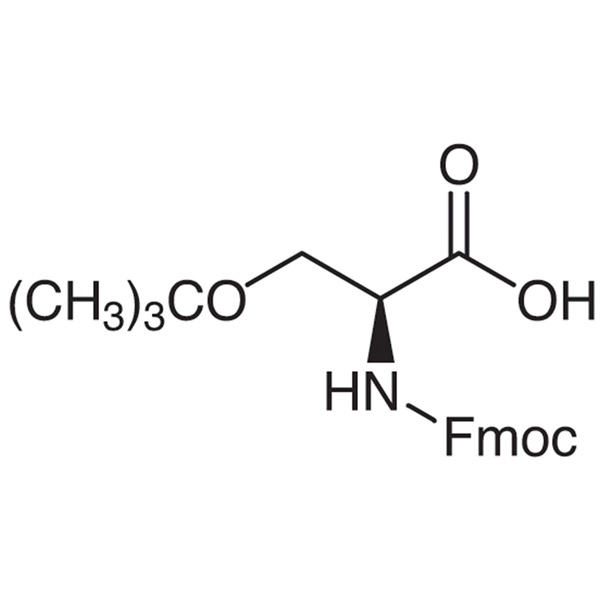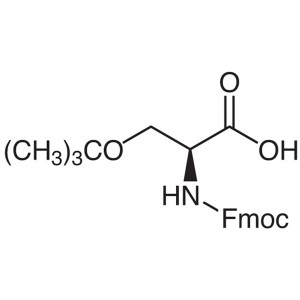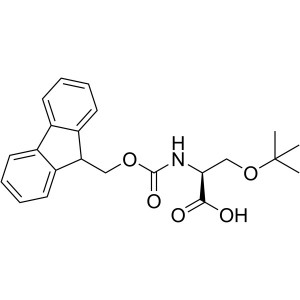Fmoc-Ser(tBu)-OH CAS 71989-33-8 Fmoc-O-tert-Butyl-L-Serine Purity >98.5% (HPLC)
Shanghai Ruifu Chemical Co., Ltd. is the leading manufacturer of Fmoc-O-tert-Butyl-L-Serine (Fmoc-Ser(tBu)-OH) (CAS: 71989-33-8) with high quality. Ruifu Chemical supplys a series of amino acids. We can provide worldwide delivery, competitive price, small and bulk quantities available. Purchase Fmoc-Ser(tBu)-OH, Please contact: alvin@ruifuchem.com
| Chemical Name | Fmoc-O-tert-Butyl-L-Serine |
| Synonyms | Fmoc-Ser(tBu)-OH; Fmoc-L-Ser(tBu)-OH; N-Fmoc-O-tert-Butyl-L-Serine; O-tert-Butyl-N-Fmoc-L-Serine; O-tert-Butyl-N-[(9H-Fluoren-9-ylmethoxy)carbonyl]-L-Serine; N-(9-Fluorenylmethoxycarbonyl)-O-tert-Butyl-L-Serine |
| Stock Status | In Stock, Production Capacity to Tons per Month |
| CAS Number | 71989-33-8 |
| Molecular Formula | C22H25NO5 |
| Molecular Weight | 383.44 g/mol |
| Melting Point | 125.0~140.0℃ |
| Density | 1.216 |
| Storage Temp. | Cool & Dry Place (2~8℃) |
| COA & MSDS | Available |
| Category | Fmoc-Amino Acids |
| Brand | Ruifu Chemical |
| Items | Inspection Standards | Results |
| Appearance | White Powder | White Powder |
| Specific Rotation [α]20/D | +25.0°±2.5° (C=1 in EtOAc) |
+24.8° |
| Melting Point | 125.0~140.0℃ | 130.6~131.1℃ |
| Water by Karl Fischer | <1.00% | 0.194% |
| Loss on Drying | <1.00% | 0.32% |
| Residue on Ignition | <0.10% | <0.10% |
| Optical Purity | <0.30% D-Enantiomer | 0.0782% |
| Clarity of Solution | 0.3 gram in 2ml DMF Clear Solution | Complies |
| Purity / Analysis Method | >98.5% (HPLC) | 99.15% |
| 300 MHz 1H | Conforms to Structure | Complies |
| Elemental Analysis | Consistent | Consistent |
| TLC Analysis | One Spot | Complies |
| Infrared Spectrum | Conforms to Structure | Complies |
| Conclusion | The product has been tested & complies with the given specifications | |
Package: Fluorinated Bottle, Aluminium foil bag, 25kg/Cardboard Drum, or according to customer's requirement.
Storage Condition: Store in sealed containers at cool and dry (2~8℃) warehouse away from incompatible substances. Protect from light and moisture.
How to Purchase? Please contact Dr. Alvin Huang: sales@ruifuchem.com or alvin@ruifuchem.com
15 Years Experience? We have more than 15 years of experience in the manufacture and export of a wide range of high quality pharmaceutical intermediates or fine chemicals.
Main Markets? Sell to domestic market, North America, Europe, India, Korea, Japanese, Australia, etc.
Advantages? Superior quality, affordable price, professional services and technical support, fast delivery.
Quality Assurance? Strict quality control system. Professional equipment for analysis include NMR, LC-MS, GC, HPLC, ICP-MS, UV, IR, OR, K.F, ROI, LOD, MP, Clarity, Solubility, Microbial limit test, etc.
Samples? Most products provide free samples for quality evaluation, shipping cost should be paid by customers.
Factory Audit? Factory audit welcome. Please make an appointment in advance.
MOQ? No MOQ. Small order is acceptable.
Delivery Time? If within stock, three days delivery guaranteed.
Transportation? By Express (FedEx, DHL), by Air, by Sea.
Documents? After sales service: COA, MOA, ROS, MSDS, etc. can be provided.
Custom Synthesis? Can provide custom synthesis services to best fit your research needs.
Payment Terms? Proforma invoice will be sent first after confirmation of order, enclosed our bank information. Payment by T/T (Telex Transfer), PayPal, Western Union, etc.
Inspection procedures
1. Appearance
-- Visual inspection
2. Purity (HPLC)
2.1 Instrument
High performance liquid chromatography, PDA detector.
Electronic analytical balance
2.2 Reagent
Acetonitrile (chromatographic grade), trifluoroacetic acid (chromatographic grade)
2.3 Chromatographic conditions
2.3.1 Column: YMC-ODS-AM, 5 μl, 250x4.6 mm
2.3.2 Detection wavelength: INC220nm
Flow rate: 1.0mL/min
Sample size:10 μl (reference)
Diluent: acetonitrile
Data collection time: 25.00min
2.4 Mobile phase preparation
Mobile phase A (0.1% trifluoroacetic acid water): precision absorption 2. Dilute Oml trifluoroacetic acid with water to 2000m1, mix well, and degassing;
Mobile phase B (0.1% acetonitrile trifluoroacetic acid): precise absorption 2.0ml trifluoroacetic acid was diluted to 2000m1 with acetonitrile, mixed and degassing;
2.5 Gradient program of mobile phase
Time (min) A% B%
0.00 90 10
13.00 10 90
18.00 10 90
18.01 90 10
23.00 90 10
2.6 Preparation of sample solution
Weigh and dissolve 0.1g sample with acetonitrile and dilute to 100ml, shake well for use, or the same concentration. Prepare two samples in parallel.
2.7 Sample Determination
Analyze the sample according to the following sampling procedure:
More than 1 injection of blank solution
1 stitch sample solution 1#
1 stitch sample solution 2#
2.8 Result calculation
2.8.1 The peak area normalization method was used to calculate the HPLC purity by deducting blank space.
2.8.2 The relative mean deviation of purity of two needles shall not be greater than 1%
2.8.3 If the results of both injections meet the acceptance criteria, the average purity is taken as the final result.
3, Melting point -- RY-1 melting point instrument
4. Loss on drying detection method
4.1 Instruments:
Electric thermostatic drying oven, one in ten thousand balance.
4.2 Procedure:
In a flat weighing bottle with a ground mouth cover with constant weight and over-drying, weigh 1 gram of sample (accurate to 0.0001 gram). The sample should be evenly spread at the bottom of the weighing bottle with a thickness of no more than 10mm, put in a constant temperature electric drying oven, dry at 105-110 ℃ for 3 hours, and then move into the drying room, cool to room temperature and weigh.
Calculation: Dry weight loss %= (M1-M2) ÷M×100
Where: M1: mass of sample and weighing bottle before drying, g
M2: Mass of sample and weighing bottle after drying, g
M: Sample mass, gram
5. Specific rotation
-- Specific rotation is measured in accordance with GB/T613-1988
Sample preparation: 0.5000g of sample was accurately weighed and transferred to a clean and dry 50ml volumetric bottle with 20ml Ethyl acetate. The bottle was corked and shaken to dissolve the Ethyl acetate.
Test: Adjust the zero of the gyroscope before the test, then fill the test tube with sample solution, record the deflection Angle of rotation, and calculate the specific rotation of the sample using the following formula.
[α]20/D= (r×50) ÷(L×W)
Where:
[α]20/D: Specific rotation of sample solution at 25℃
r: Rotation observed at 25℃ for sample solution
50: Prepare sample solution volume (ml)
w: Sample weight (g)
L: Optical tube length (dm)
6. TCL Analysis
Sample preparation: 0.5000g sample was accurately weighed and moved to a clean and dry 50ml volumetric bottle, 40ml EtoH was added, the bottle was capped and shaken to dissolve, and then diluted to the scale with EtoH.
Preparation of control sample: 0.5000g sample was accurately weighed and moved to a clean and dry 50ml volumetric bottle, 40ml water and 2 drops of 6N hydrochloric acid were added, the bottle was capped and shaken to dissolve, and then diluted to the scale with water. Then take 0.5 of the above liquid and dilute it with ethanol in a 100ml volume bottle to a reference sample with 1.0% amino acid residue scale.
10 microliter samples were taken with a microsampling syringe, and the samples were placed on the GF254 silicone plate. 5 microliter, 10 microliter and 15 microliter point plates were taken for comparison points, respectively.
Developing agent: n-butanol: glacial acetic acid: water =4:1:1.
Color developing agent: 5% ninhydrin methanol solution.
Color development operation: first, use a hair dryer to dry the developed silica gel plate, then dip it into 5% ninhydrin methanol solution, then blow dry, and bake at high temperature in an electric furnace for color development.
Judgment: Look at the product color time, spot size, color concentration and comparison with the control product, judge that it is in that range.
Hazard Symbols Xi - Irritant
Risk Codes 36/37/38 - Irritating to eyes, respiratory system and skin.
Safety Description S24/25 - Avoid contact with skin and eyes.
S36/37/39 - Wear suitable protective clothing, gloves and eye/face protection.
S27 - Take off immediately all contaminated clothing.
S26 - In case of contact with eyes, rinse immediately with plenty of water and seek medical advice.
WGK Germany 3
HS Code 2922491990
Fmoc-O-tert-Butyl-L-Serine (Fmoc-Ser(tBu)-OH) (CAS: 71989-33-8) is a serine derivative.
Fmoc-amino acids, used as amino acid protecting monomer, used in peptide synthesis, Fmoc solid-phase peptide synthesis, used as an organic synthesis intermediate, pharmaceutical intermediate, biochemical reagent or chemical reagent.
Fmoc-Ser(tBu)-OH is an N-terminal protected reagent used in the peptide synthesis. Some of the reported examples are: Total synthesis of an antibiotic, daptomycin, by cyclization via a chemoselective serine ligation. Preparation of MUC1, a T-cell helper peptide, using iterative pentafluorophenyl ester-mediated fragment condensations. Linear solid-phase peptide synthesis of ubiquitin and diubiquitin.
Production method O-tert-Butyl-L-Serine is suspended in dioxane solution, the crude product is obtained by acylation reaction with fluorenylmethoxycarbonyl azide, which is extracted with ethyl acetate at pH 9-10 and purified by recrystallization.
-
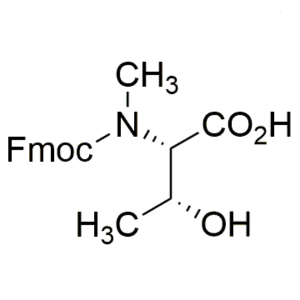
Fmoc-N-Me-Thr-OH CAS 252049-06-2 Fmoc-N-Methyl-...
-
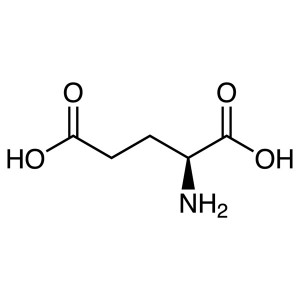
L-Glutamic Acid CAS 56-86-0 (H-Glu-OH) Assay 98...
-
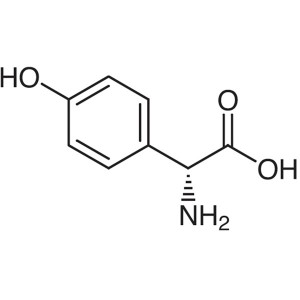
D-4-Hydroxyphenylglycine CAS 22818-40-2 Purity ...
-
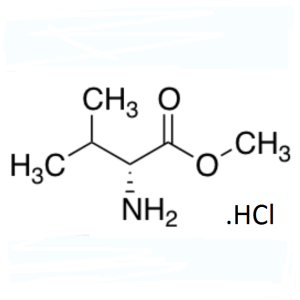
H-D-Val-OMe·HCl CAS 21685-47-2 D-Valine Methyl ...
-
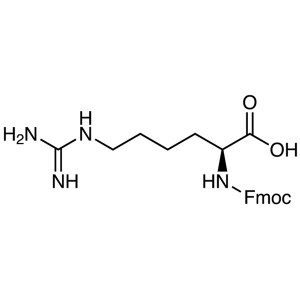
Fmoc-L-Homoarginine CAS 776277-76-0 Assay ≥97.0...
-
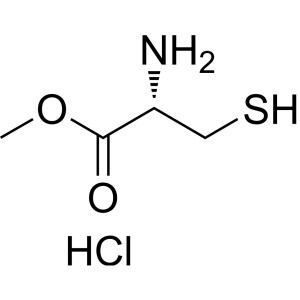
D-Cysteine Methyl Ester Hydrochloride CAS 70361...

